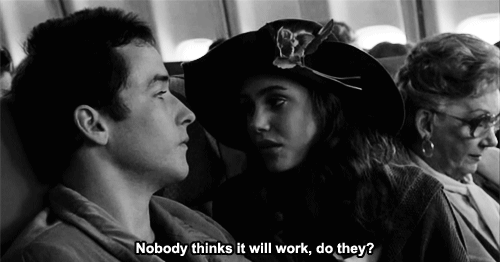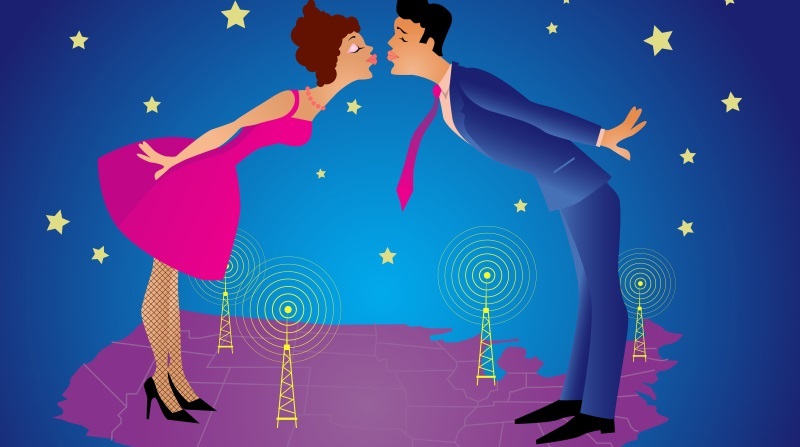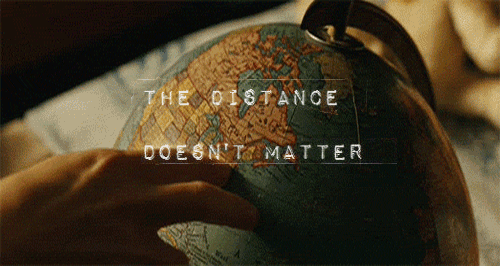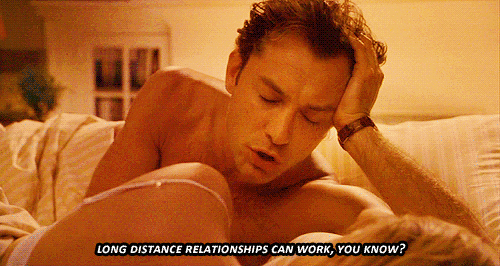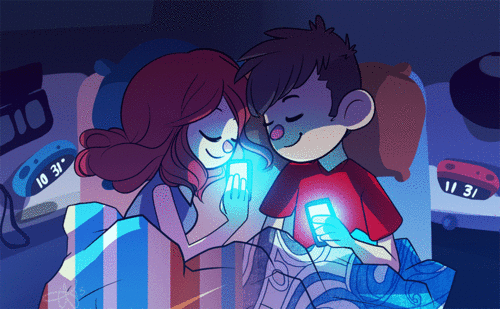An hour into Going The Distance, (yep, once again) and I decided I had to write this. Out popped my pink lappy, with my own name in embossed letters all over it, and soon I was typing away with a speed that has been missing from my wonky work hours, for some time now. And why wouldn’t I have? After all, I have been in a long distance relationship for three years and can vouch for the falsity of the so-called colloquial wisdom about long distance relationships never working out. I am a breathing nominal of a long-distance relationship not just surviving the vagaries of time and distance but thriving on them! And before you write me off as a one-off case, let me tell you, I am not alone. There are countless others! Don’t believe me??? Let’s take a look at the numbers:
- About 14 million couples in the United States are in a long-distance relationship
- Almost four to four and a half million of these couples are in a non-marital relationship
- 3.75 million married couples are in a long-distance relationship
- 75% of all engaged couples have, at some point in their affair, been in a long distance relationship
- Among these, 32.5% are college long-distance relationships
- It would be more interesting for you to note that 2.9% of all married couples in the States live in a long distance relationship whilst a whopping 10% of all marriages in the States started out as a long-distance relationship
Now now, they wouldn’t get married for naught, right? I am hoping these numbers evince that long distance relationships do WORK, despite the whole colloquial boo-hoo surrounding trading texts, Skyping or meeting once in a while being ‘okay’ until the heartache of being apart and leading separate lives gets to you!!! And if you still aren’t convinced and wondering, do long distance relationships work, I have got more!
A number of scientific studies have shown that more than 86% of couples in long distance relationships report a higher level of intimacy and connect than their geographically-close counterparts. A study published in the Journal of Communication confirms,
“While the public and the science community hold a pessimistic view towards long distance (LD), this research provides compelling support for the opposite side – long distance is not necessarily inferior to geographically close dating.”
Suggested read: Does a long distance relationship mean the end of the road for the couple?
Crystal Jiang, an assistant professor of communication at City University of Hong Kong, reports that long distance couples are more likely to share meaningful thoughts and feelings, and therefore, experience a deeper sense of emotional intimacy.
In the face of the on-the-rise trend of ‘commuter marriages’ in an increasingly global job market, these social science studies seem to be welcome news. With married couples living apart from their spouses, college couples separated by thousands of miles owing to academic commitments, and non-married, non-college couples staying away from each other for countless other reasons, it is reassuring to hear about actual scientific data that evinces that long distance relationships do work out.
Image source: Shutterstock
In fact, in a study conducted on 63 heterosexual long distance dating couples who independently completed online surveys every day for one week, 80% considered their relationship committed or serious, and the average length of their relationships was 22 months. On an average, the long distance couples had been separated for about 17 months. Researchers also asked the participating couples to track their interactions with their partners: how often they communicated, how long they talked, and what they used to do it – phone calls, video chats, instant messages, email, texting or seeing each other face-to-face. The results seemed to reiterate those published in the Journal of Communication. The participants reported having ‘lesser interaction’ than the couples who lived closer to each other. However, the ‘long distance lovers’ reported a higher level and intensity of intimacy than those who were geographically closer.
However, these social science studies are prompt to caution their audiences that not everyone can thrive in this kind of romantic commitment. While ‘distance may indeed make the heart grow fonder,’ researchers issue a prompt disclaimer to the long distance lovers about being wary of their specific approach toward the ‘distance’ that separates or in turn, brings them closer. If you find yourself skeptikal and thinking ‘How to make a long distance relationship work?’ it’s pretty easy, provided one understands the challenges and problems implicit in the long distance equation.
Problems and challenges of a long distance relationship
Contrary to popular belief, ‘distance’ isn’t quite the hardest part of long-distance relationships. Emma Dargie, a PhD student in clinical psychology at Queen’s University, along with a team of researchers at Queen’s University, published a paper last year that compared relationship quality between long distance couples and geographically-close couples. In their study, the researchers gave 474 females and 243 males in long distance relationships a series of questions on topics including intimacy, commitment, communication, and sexual satisfaction (or lack thereof). The researchers, then put the same questions to 314 females and 111 males who lived geographically closer to their partners. It was found that quality of relationship was not different for either type of couple. Oddly enough, for long distance couples, the farther the partners were, the greater their levels of intimacy, communication, and commitment. This proved that the biggest challenge to making a long distance relationship work wasn’t distance!!
Dargie explained,
“According to our research, it’s not necessarily how far apart you are or how little you see your partners. It’s more about the discrepancy between your expectations for relationships and the reality of your current situation.”
I could not agree more. And I can bet my last dollar that those of you sailing in the long distance boat or the ones who have braved the sail upstream are nodding too. Most of the times, we tend to overlook the subjective markers of relationship satisfaction because the blatantly objective ones (distance, for example in case of long distance relationships) are too overwhelming to go unnoticed. There are a number of studies to support this conclusion. In one study assessing relationship certainty, individuals in long distance relationships were asked whether they were certain to live in the same city as their partner in the near future. They were also asked how satisfied they were with that potential outcome. Results showed that being uncertain was related to greater levels of distress and lower levels of satisfaction. It is interesting that regardless of certainty, greater satisfaction with that possible outcome predicted higher levels of overall relationship satisfaction and lower levels of relationship distress (Maguire, 2007). Thus, it is highly likely that satisfaction with a relationship’s predicted progression or trajectory plays a key role in its survival, surpassing the effect of the merely objective factors.
Suggested read: 10 things you’ll relate to if you’re in a long distance relationship
All the mischief-making imps associated with long distance relationships fall within the ambit of this one major obstacle to overcome – the discrepancy between your expectations for relationships and the reality of your current situation. Whether it be grappling with uncertainty or insecurity or even just the unbearable pain of being miles away or something else, any/all of these problems can be effectively tackled by bridging the gap between one’s expectations of the relationship and the reality of the situation in order to make your long distance relationship thrive.
So, how does one do that?
Tips and advice on how to make a long distance relationship work
A lot of the bridging happens at a semi-conscious level vis-à-vis coping patterns that are commonly found across various types and subtypes of long distance relationships. Being farther apart makes individuals adapt several cognitive coping strategies such as cognitive dissonance (i.e., convincing oneself of positive outcomes to justify engaging in a challenging relationship type) or idealization (i.e., focusing on positive relationship traits while ignoring negative traits) to focus on the positive aspects of their relationship, justifying their choice to continue their union despite great challenge. This also enabled them to be more optimistic about the future of their relationship than the geographically close couples, although they weren’t any less likely to end their relationship than their counterparts. It was purely the exhortation by this subconscious engagement with the long distance dynamic that helped them deploy better and efficacious tools of interpersonal coping to make their long distance relationships work. As a result, they were investing additional resources into cultivating aspects of their relationship, such as their levels of intimacy and communication.
Of course, the times that the couples met face-to-face and their proficiency in optimizing their use of available resources (among them, technology) to maximize their relationship quality was a pivotal factor to gauge satisfaction levels. However, in a study conducted by Stafford and Merolla, it was reported that the amount of variance of the relationship satisfaction outcome variable is most pronounced whilst varying the subjective predictors. And hence, a couple’s beliefs, attitudes, approach, commitment, willingness to invest, mode of communication, levels of psychological distress (or lack thereof), ability to trust, and an overall compatible scale of desires (sexual or otherwise) are potent markers for assessing the satisfaction levels and quality in a long distance relationship.
Suggested read: 15 surprisingly simple long distance relationship advice
Dargie maintains that the single best advice to have a healthy long distance relationship is to have effective communication.
“Establish the needs of each partner early on, practice working towards meeting those needs, and give feedback about which needs are still being unmet,” says Dargie, “These needs can include agreeing on anything from on how often the couple communicates to how frequently they take time to see each other in person. In fact, it’s important to set dates for meet ups. Going long distance with no end in sight can be trickier.”
Whilst there is no denying that communication forms an integral part of braving the ‘long distance’ challenges, another crucial element in making long distance relationships work is endurance. Endurance, I believe, is key to longevity of long distance relationships. Not only does the forbearance help in a near-stoic acceptance of the harsh realities of being farther apart but they enable the long distance lovers to bear the separation better and be optimistic about their potential future.
The numbers in the department are quite telling. The average distance in a long distance relationship is noted to be 125 miles. The average number of letters couples write to each other per month is 3 while they happen to see each other around 1.5 times on an average each month. 2.7 days pass between the partners video-calling each other and there is an average gap of 14 months before the couple expects to move back together. As such, the importance of dissolving the distance and ‘making the heart grow fonder’ is gaining more and more significance. It is at this juncture that technology comes to the rescue. Technology can not only help establish an enabling and optimal channel/s of communication but also accredit optimal levels of endurance to sustain the rigors of a long distance relationship.
Technology to the rescue
The study of 63 couples, published in the Journal of Communication in 2013, found that digital media, like video chatting and texting, may help couples achieve healthy long distance relationships – at least among younger daters. (The average age of research participants was 21, and the authors cautioned in the paper that “the sample of tech-savvy college students may limit the generalizability of the conclusions.”) However, with a large majority of the population finding technology an inevitable force, which can only be reckoned with, it is becoming increasingly easier for couples in a long distance relationship to communicate and reinforce intimacy. As such, it has been observed in recent studies that although the people in a long distance relationship did not interact as frequently throughout the day, their interactions are longer and more intimate.
And therefore, no matter what the GPS says about the distance, there exists, indeed, a heart-picked list (courtesy ME) of apps that can stave off those miles and bring you closer. Let’s take a look at the long distance relationship apps:
- Avocado: Created by a pair of lovers, this lovers’ special app allows you to share lists and send virtual hugs by holding the phone close to your heart. You can archive all you do so that you can actually track the trajectory of your relationship as your (avocado) tree of love starts to reap fruit. (Coz you know an avocado tree doesn’t bear fruit until there’s another tree nearby – and even if you are farther apart, this app brings you quite close, doesn’t it?)

- Snapchat: For long distance lovers or any pair of lovers for that matter, this one is pure genius. Click a risqué picture of yourself and warm the heart (and more) of your lover, sitting halfway across the country/continent. Just for a few seconds. Hot, eh?

- TheIceBreak: This one’s just a light-hearted fun game to grade the knowledge you have about your partner. Could get risky, but what’s love without a little risk, huh? Take the distance and turn it into a remembrance token.
- We-Connect: Phone sex became more real and raunchy!! Don’t believe me, try We-Connect’s We-Vibe feature to spice things up a few notches!

- Couple: Now this one may not be everyone’s cup of tea but for those who have a thing for ‘stalking,’ this one might just be perrrrfectttt. You can collect all your sappy photos and messages in one place and see where your partner is at, using geolocation. Also, this one’s very popular for its ‘Thumbkiss.’
- HeyTell: Swap quick audio clips on the go walkie-talkie style! Fun, right? Cooler than a doodle, this one brings their voice with the whispers of the wind!! <gee>
Plus, one cannot overlook how easy and (well, almost)REAL it has all become. One can call every day, without worrying about phone bills. One can send immediate updates and share moments via texts. One can spot something he/she will certainly love and Snapchat it. If one feels the uncontrollable urge to see one’s beloved, lo, Skype or Google Hangout or FaceTime!! Not to forget, if you are a sappy old romantic, you can bombard your lover with Beyonce songs on Spotify. And one can never rule out the loyal trackers – Facebook, Instagram, and Twitter. One can even sit and watch movies together. What else could technology possibly bring? Of course, the hyper connectivity can be a double-edged sword and one needs to be able to appropriate it to suit the couple’s unique needs, in a way that the jerky reality of a video chat or a constant track of the partner’s daily activities does not widen the gap by opening critters of silence and reducing the richness and vitality of all there is to share. One has to tread upon the tech-connectivity land carefully so as to not reach the point where being connected to your partner at all times like Theodore Twombly (in the movie Her) renders the benefits of being apart null and void.
Mitigating the effects of distance through coping skills, effective communication, and fostering a partnership geared towards the creation and completion of common goals is the optimal strategy-mix for making long distance relationships work and thrive, and not just survive!!
P.S. We have amazing articles on how to make a long distance relationship work queued up for the entire week. So stay tuned for all there is to know about ’em!!
Featured image source: Google, copyright-free image under Creative Commons License



